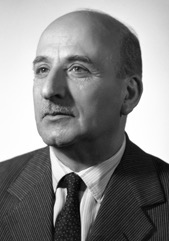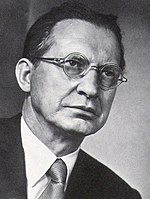
Christian Democracy was a Christian democratic political party in Italy. The DC was founded on 15 December 1943 in the Italian Social Republic as the nominal successor of the Italian People's Party, which had the same symbol, a crusader shield. As a Catholic-inspired, centrist, catch-all party comprising both centre-right and centre-left political factions, the DC played a dominant role in the politics of Italy for fifty years, and had been part of the government from soon after its inception until its final demise on 16 January 1994 amid the Tangentopoli scandals. Christian Democrats led the Italian government continuously from 1946 until 1981. The party was nicknamed the "White Whale" due to its huge organisation and official colour. During its time in government, the Italian Communist Party was the largest opposition party.
The Gruber–De Gasperi Agreement was a bilateral treaty that was signed by the foreign minister of Austria, Karl Gruber, and the prime minister of Italy, Alcide De Gasperi, on 5 September 1946. Recognized by international law, it granted the German-speaking population of the Province of Alto Adige/Südtirol the right to autonomy and to preserve its cultural identity and customs. It also recognized German and Italian as official languages.

The prime minister of Italy, officially the president of the Council of Ministers, is the head of government of the Italian Republic. The office of president of the Council of Ministers is established by articles 92–96 of the Constitution of Italy; the president of the Council of Ministers is appointed by the president of the Republic and must have the confidence of the Parliament to stay in office.

Alcide Amedeo Francesco De Gasperi was an Italian politician who founded the Christian Democracy party and served as prime minister of Italy in eight successive coalition governments from 1945 to 1953.

Fernando Tambroni Armaroli was an Italian politician. A member of Christian Democracy, he served as the 36th Prime Minister of Italy from March to July 1960. He also served as Minister of the Interior from July 1955 until February 1959, Minister of Budget and Treasury from February 1959 to March 1960, and Minister of the Merchant Navy from August 1953 until July 1955.

Mario Scelba was an Italian politician who served as the 33rd prime minister of Italy from February 1954 to July 1955. A founder of the Christian Democracy, Scelba was one of the longest-serving Minister of the Interior in the history of the republic, having served at the Viminale Palace in three distinct terms from 1947 to 1962. A fervent pro-Europeanist, he was also President of the European Parliament from March 1969 to March 1971.

Giuseppe Pella was an Italian Christian Democratic politician who served as the 31st prime minister of Italy from 1953 to 1954. He was also Minister of Treasury, Budget and of Foreign Affairs during the 1950s and early 1960s. Pella served as President of the European Parliament from 1954 to 1956 after the death of Alcide De Gasperi.

Attilio Piccioni was an Italian politician. He had been a prominent member of the Christian Democracy.

The secondDe Gasperi II government was the first government of the Italian Republic. It was established by Alcide De Gasperi following the referendum of 2 June 1946, in which the Italian people voted in favour of the Republic. It held office from 13 July 1946 until 2 February 1947, a total of 203 days, or 6 months and 18 days.

The third De Gasperi government held office in the Italian Republic from 2 February 1947 until 31 May 1947, a total of 119 days, or 3 months and 30 days.

The fourthDe Gasperi government held office in the Italian Republic from 31 May 1947 to 23 May 1948, a total of 358 days, or 11 months and 22 days.

The fifth De Gasperi government held office in the Italian Republic from 23 May 1948 until 27 January 1950, a total of 614 days, or 1 year, 8 months and 5 days.

The sixth De Gasperi government held office in the Italian Republic from 27 January 1950 until 26 July 1951, a total of 558 days, or 1 year, 5 months and 29 days.

The seventh De Gasperi government held office in the Italian Republic from 26 July 1951 until 16 July 1953, a total of 721 days, or 1 year, 11 months and 20 days.

The eighth De Gasperi government held office in the Italian Republic from 16 July to 17 August 1953, a total of just 32 days. It was the first government of the Republic to fall at its inaugural Parliamentary vote of confidence, having been submitted to Parliament by President Luigi Einaudi.

Angelo Raffaele Jervolino was an Italian Christian Democrat politician.

Umberto Tupini was an Italian politician. He was minister of public works (1947–1950) in the Government of Italy. He was the mayor of Rome (1956–1958). He served in the Senate of Italy in Legislature I (1948–1953), Legislature II (1953–1958), Legislature III (1958–1963) and Legislature IV (1963–1968). He was a knight grand cross of the Order of Merit of the Italian Republic.
The Centrism was a political formula that inspired the Atlanticist, anti-communist, and centrist governments of the Italian Republic between the end of the 1940s and the early 1950s. The governments of this period, also known as "The Years of Centrism", were characterized by a coalition pact between the Christian Democracy (DC) and the other minor secular parties.

Guido Gonella was an Italian politician from the Christian Democracy, former Minister of Public Education and Minister of Justice.











